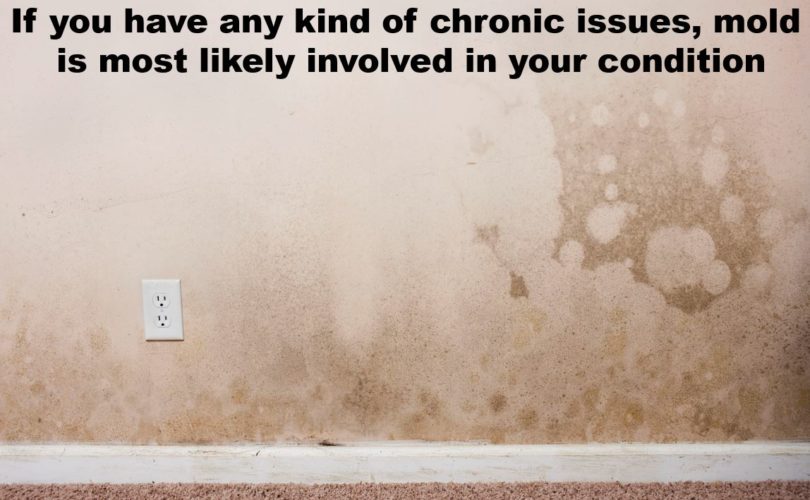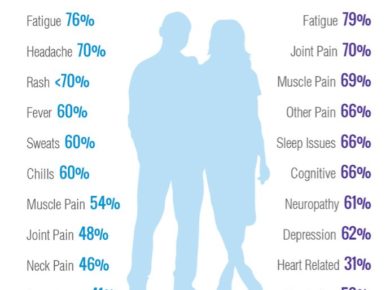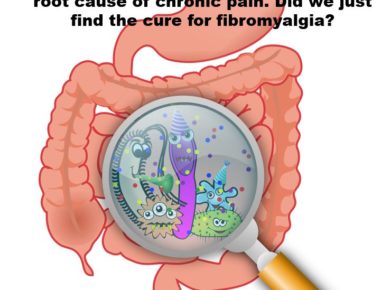Mold is a term which applies to the many different types of fungi which are found both inside and outside.
While certain molds are toxigenic, meaning they can produce toxins (specifical mycotoxins), the molds themselves are not toxic, or poisonous.
However, because more than 200 species of mold are toxin-producing, this means that they are potentially poisonous and the health dangers from them are many.
Unfortunately, molds are very common in buildings and homes where they thrive and spread in damp conditions. Indoor mold can often be found in attics, under carpets, behind drywall, in insulation, leather, fabrics, and foods.
Molds can be hazardous to health because inhabitants of moldy spaces may not be aware that it exists and are therefore unknowingly breathing in mold spores which accumulate in the body and the brain, resulting in conditions such as allergies, headaches infections, and respiratory conditions. If someone suddenly develops a runny nose, asthma, cough, or sinus issues which don’t respond to conventional treatment, they would be wise to investigate their home or workplace for mold.
Mold is the term given to different types of fungi which reproduce by forming tiny spores, so small that they cannot be seen by the naked eye. These spores travel through the air until they find a moist habitat, and then they start to grow. That is when the various types of mold can become visible.
The molds which can cause health dangers are usually found indoors and can be white or greenish in color or, in the case of Stachybotrys atra, black which gives it the more commonly-used name, Black Mold.
Preventing Mold
The easiest way of preventing mold is by ensuring the building is free of any moisture. This includes:
- repairing leaks in plumbing or other structures and cleaning up thoroughly afterward
- wiping up condensation on windows and in bathrooms
- avoid carpet in the bathroom and run an extractor fan when showering
- checking air ducts
- removing mats or carpets which may have got damp
- eliminating standing water in drains
- keeping indoor humidity levels to between 30%-50% by running fans, air conditioning or dehumidifiers
- venting appliances which produce moisture such as stoves and clothes dryers
- use mold inhibitors which can be added to paints
- clean bathroom with mold-killing products
- adding insulation can reduce the potential for condensation on cold surfaces (such as windows, piping, roof, or floors)
Eliminating Mold
If small amounts of mold are present, they can be removed with mold or mildew removal products or by applying a solution of bleach and water to the area. Rubber or nonporous gloves should be worn along with protective eyewear. A mask of some kind should also be worn, and these are usually available at hardware stores. Never ever touch mold of any kind with bare hands.
Widespread mold usually requires specialized treatment by a mold specialist. Even after the mold has been eliminated, it may be wise to run an air cleaning machine of some kind to thoroughly rid the area.
Health Dangers from Mold
The toxins produced by mold can be very harmful, and the health dangers from mold are many and varied. According to the Environmental Protection Agency (EPA), all molds have the potential to cause ill health. Exposure to mold and how it affects the body can differ from person to person. Symptoms depend, in part, on the types of mold present, the extent of exposure, general health, and existing sensitivities or allergies.
The most common indoor mold varieties include:
- Alternaria: Alternaria is a mold that is found in the upper respiratory tract. It causes allergic responses, including itchy eyes, runny nose, and coughing.
- Aspergillus: This variety of mold is most likely to be found in house dust. Aspergillus produces mycotoxins that can lead to lung infection. Warm, damp climates are most susceptible to this type of mold.
- Cladosporium: This fungus is regularly found outdoors, but has been known to grow on wood and textiles inside homes. Symptoms are similar to those of hay fever and asthma.
- Penicillium: Penicillium mold produces symptoms similar to the Alternaria variety. Penicillium is found on carpet, fabrics, insulation, and wallpaper.
- Stachybotrys: This is more commonly referred to as “black mold.” This more toxic variety is usually found on paper or wood and causes the most severe symptoms such as serious respiratory issues and bleeding in the lungs.
Mold toxins are fatty in their molecular structure and they can travel around the body via the bloodstream and can easily cross the blood/brain barrier. The brain is made up of 60% fatty content which makes it an ideal habitat for mold toxins and accumulation of which can lead to neurological conditions such as Parkinson’s and Multiple Sclerosis.
Effects of Mold
It is estimated that over 25% of buildings in the United States have had some degree of water damage. Often, these leaky roofs, buckling floorboards, and water stains will be ignored. They may be unsightly to the building’s overall aesthetic, but the many people working or living inside those buildings do not jump to the conclusion that those unsightly water damage spots could be hazardous to their health.
But more and more, doctors in alternative medicine are discovering that many of their patient’s chronic ailments are the result of mold toxicity. Because mold spores are invisible to the naked eye, it’s not easy to make the connection. However, understanding the effects of mold will help you to determine whether or not you might be afflicted with mold toxicity.
Could You Have Mold Poisoning?
The signs, and symptoms of mold toxicity are usually evident, but often difficult to pin on a direct cause. Depending on the severity of mold poisoning, symptoms can be attributed to long-term cold or seasonal allergies. Allergies are an immune response to pollen and dust, causing the immune system to react as it attempts to rid the body of this irritant. In much the same way, mold causes a chronic immune reaction. But if exposure to mold is sustained, symptoms do not go away. The continual inhalation of the toxic mold spores reduces your body’s chances of fighting back. Understanding mold poisoning, black mold poisoning, and poisoning symptoms requires an investigative mindset.
Here are some suggestions:
- Have you been feeling ill or unwell for a period that surpasses the timeline of a common cold?
- Have you sought medical help and been diagnosed with seasonal allergies, yet symptoms have not subsided?
- Have symptoms worsened since their onset, and has it impacted your well-being?
- Can you smell mold in your home, or do you have trouble breathing in certain areas?
- Are others in your home not feeling well, having headaches or respiratory issues?
- Do your symptoms come and go and frequently change? Day to day, week to week, or even month to month?
If you answered yes to any or all of these questions, you should not rule out mold poisoning or toxicity as a cause of your symptoms. Often, mainstream medical practitioners are not aware of the hazardous, and all-too-common effects mold has on the body.
If you feel that you’ve been unwell for some time, even if symptoms feel minor and negligible, there is a chance that you could be a host for toxic mold spores. Depending on your genes and susceptibility to illness, your symptoms could range from mild to severe, but extended exposure to mold will worsen these effects.
What is Mold Sickness?
Mold affects multiple systems in the body. The fatty molecular structure of mold allows it to cross the blood-brain barrier, generating a flurry of unwanted symptoms. The immune response triggers a range of reactions as well, depending on genetic predisposition and other environmental toxins at play. Symptoms of mold sickness may vary, but the overall impact on your health is much the same. No matter whether or not you’re able to live a relatively functional live under the threat of mold sickness is irrelevant. Inhaling toxic mold spores over an extended period will eventually break down your body’s defenses, leading to a lower quality of life and potential life-threatening long-term conditions. Black mold sickness and other mold sickness requires immediate attention as soon as it is identified.
Black Mold Symptoms
The most toxic variety of mold is black mold. Black mold grows on materials that have high cellulose content. Dark greenish-black mold found on wood, paper, gypsum board, dust, and lint are all common indicators that there is a lot of moisture or previous water damage.
- Respiratory irritation
- Chronic coughing and sneezing
- Irritation of the eyes
- Irritation of mucous membranes of the nose and throat
- Shortness of breath or cough
- Skin rashes
- Chronic Fatigue
- Bleeding of the lungs
- Nausea
- Vomiting
Other Illnesses Generated from Mold
What is often referred to as mold illness or mold sickness is actually the condition of chronic inflammatory response syndrome or CIRS. The agents that cause this condition are a range of biotoxins that come from several sources. Fungi, mold spores, and VOCs are all examples of biotoxins that can cause CIRS and other chronic symptoms. Considering that much of the population has been exposed to a moderate-high level of biotoxins in their life, it is no surprise that nearly 25% of the population is prone to develop CIRS in their lifetime.
Most of the time, once people afflicted with CIRS are removed from their toxic environment, symptoms will subside, and the body will begin the natural healing process. However, those who have been exposed to the biotoxins for an extended period or those who have a naturally susceptible immune system will have to seek medical assistance to rid their body of the toxic spores. Depending on the extent of the mold damage within your home, you may need to seek out a professional service to hunt down the source of the mold, disinfect the area, and clean the air using a filtration system.
Mold illness, mold sickness, or CIRS is often misdiagnosed. It’s not that doctors are oblivious to the dangers of mold, it’s the fact that they’re simply not looking for it. With such a wide range of symptoms, CIRS and other illnesses from mold are simply misattributed to other conditions like allergies or fibromyalgia. Treating mold illness symptoms with medicine made for other conditions does nothing to rid your body of the illness. Rather, the toxic mold within your home will continue to grow and spread while your condition slowly worsens over time. Furthermore, the medicine you are taking for an unrelated condition could interfere with and inhibit your immune system’s ability to fight the toxic spores.
The non-specific symptoms of CIRS include:
- Fatigue
- Memory & concentration problems
- Headaches
- Vertigo
- Hypersensitivity to light
- Cough
- Congestion
- Runny nose
- Shortness of Breath
- Nausea
- Cramping
- Diarrhea
- Muscle and joint pain
- Headache
- Anxiety
- Depression
- Memory Loss
- Visual Disturbances
- Immune System Disturbances
- GI Problems
Because the symptoms are nonspecific; they cannot be attributed specifically to CIRS or any other mold illness. Black mold illness may lead to the more severe spectrum of symptoms but is still likely to be misdiagnosed.
Mold Can Cause Infection
The Mayo Clinic conducted research in the 90s that strongly suggests most chronic sinus infections are actually the result of fungi, not bacteria. Unfortunately, most sinus infections are immediately treated with antibiotics, which kill bacteria but do nothing for fungal spores. If patients have found relief from sinus infections after taking antibiotics, it is most likely due to the body ridding itself of the fungal infection, because antibiotics would not affect the spores. This mistreatment could prove to be problematic in the future, as antibiotics kill the good bacteria that flourish in the gut. This good bacteria is necessary for a properly functioning immune system.
The Mayo Clinic proposed that 96% of the people afflicted with chronic sinusitis are actually experiencing symptoms due to the immune response to fungus. Mold infections in the lungs can lead to bronchitis and other respiratory infections if left untreated. Mold infection symptoms are often attributed to other illnesses baring similar symptoms. But mold infection treatment requires that the patient be removed from the toxic environment so that their immune system can effectively push the toxic spores out of the body. If your immune system is suppressed in any way, either due to long-term exposure to such toxins or genetic predisposition, you may need to seek out alternative healthcare that works to rebuild your immune system from the inside out using a combination of effective natural treatments.






